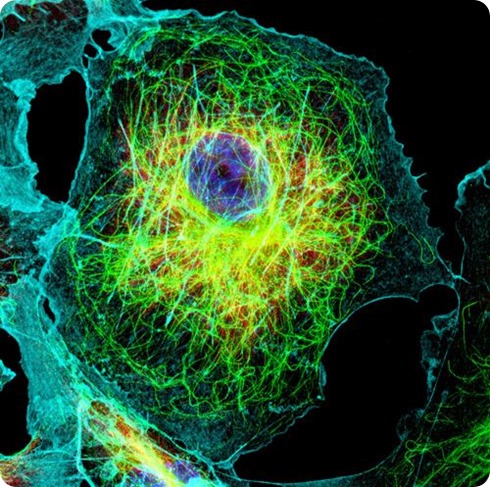With the Super-Resolution Technology HyVolution 2 and the Leica TCS SP8 STED ONE Nanoscope, Leica Microsystems expands its product portfolio for light microscopy having resolution beyond the diffraction limit.

Dr. Eugene Katrukha, Utrecht University, The Netherlands.
With these technologies, scientists in neurobiology, cancer research, and immunology can visualize molecular interactions and structures in living cells in order to understand life’s true nature.
With HyVolution 2 and the Leica TCS SP8 STED ONE, Leica Microsystems offers researchers and imaging facilities attractive solutions for getting started using super-resolution and nanoscopy.
“During the last 20 years, super-resolution and nanoscopy have revolutionized research on functional interactions inside cells at the molecular level. This is also reflected in the Nobel Prize for Chemistry of 2014“
Markus Lusser, President of Leica Microsystems.
“These technologies are well on their way to establish themselves as standard fluorescence methods for fundamental biomedical research. On the basis of our proven TCSSP8 platform, we now offer a complete portfolio for confocal imaging beyond the diffraction limit: from HyVolution 2 for super resolution at the touch of a button – to the TCS SP8 STED ONE for getting started in 3D-Nanoscopy – to our successful TCS STED 3X for multi-color STED imaging over the full spectral range."
"Leica Microsystems is the only company which has more than 12 years of experience in developing commercial imaging systems that can resolve beyond the diffraction limit.“ added Markus Lusser.
With the HyVolution 2 Super-Resolution Technology allowing resolution down to 140 nanometers, processes and structures can be resolved in several colors simultaneously with high acquisition speed and high signal-to-noise ratio.
HyVolution 2, which is available for all existing and new Leica TCS SP8 systems, combines highly sensitive Leica HyD Hybrid Detectors, the Leica TCS SP8 spectral detection system, seamlessly integrated Huygens deconvolution software, and high speed graphic processors.
The Leica TCS SP8 STED ONE Nanoscope achieves a resolution down to 30 nanometers. The system reveals morphology and dynamics inside cells at the molecular level – in 2D and 3D – and allows the co-localization of molecules to be reliably quantified.
For different applications, the STED ONE is available either with a 592 or 660 STEDlaser. The spectral detection system combines sensitivity with the Leica HyDs and freely selectable excitation wavelength of the white light laser to make the Leica TCS SP8 STED ONE a flexible imaging system.